Ischias-Schmerzen sind ein ziemlich häufiges Phänomen. Und als Yogalehrer/in triffst du in deinem Unterricht oft auf Schüler/innen, die sich von einem Ischiasschmerz erholen.
Wie kann also eine Yogapraxis Menschen mit Ischiasbeschwerden helfen?
Menschen, die unter Ischiasschmerzen leiden, und Menschen, die andere Rückenschmerzen haben, finden es schwierig, viele tägliche Aktivitäten auszuführen. Das beeinträchtigt ihre Lebensqualität und hält sie davon ab, den Aktivitäten nachzugehen, die sie eigentlich machen könnten.
Millionen von Menschen auf der ganzen Welt leiden unter Ischiasschmerzen. Und leider leben die meisten von ihnen mit den Schmerzen, ohne von den Vorteilen zu wissen, die Yoga bietet. Für Yogalehrer/innen kann es eine wirklich kraftvolle Erfahrung sein, die Vorteile von Yoga zu all denjenigen zu bringen, die sie brauchen, aber nicht wissen, dass es sie gibt.
Yoga gegen Ischias ist eine wirksame Methode, um die damit verbundenen Symptome zu lindern und Nervenschmerzen vorzubeugen. Yoga-Asanas, zusammen mit bewussten, langsamen Atemzügen, können Rückenschmerzpatienten und Menschen mit Ischias immense Linderung verschaffen. Es gibt ihnen die richtige Unterstützung, um ihre Schmerzen in den Griff zu bekommen und ernsthafte Komplikationen zu verhindern. Natürlich ist Yoga kein Ersatz für eine Physiotherapie oder den Rat eines Arztes. Aber die richtigen Asanas in der richtigen Abfolge und unter Berücksichtigung der individuellen medizinischen Diagnose sind durchaus wirksam.
Erfahre mit uns, was Ischias ist, welche Symptome und Ursachen es gibt und welche Yogastellungen am besten geeignet sind, um Ischiasschmerzen zu lindern und vorzubeugen.
Ischias kennenlernen
Schmerzen des Ischiasnervs sind in der medizinischen Fachwelt schon lange ein wichtiges Thema. Seit den frühesten Tagen wird versucht, die Ischias-Symptome und die Ursachen für dieses Leiden zu verstehen.
In der Vergangenheit wurde viel über Ischiasnervenschmerzen und die Gründe für ihr Auftreten geforscht. Bereits im 2. Jahrhundert n. Chr. finden wir in traditionellen iranischen Medizinbüchern Hinweise auf Ischiasschmerzen. Von dieser Zeit an bis weit ins 20. Jahrhundert hinein beeinflussten diese traditionellen Ansichten die Art und Weise, wie Ischias diagnostiziert wurde. Die alten Mediziner betrachteten Ischiasschmerzen als ein Problem der "Vene" und nicht des Ischiasnervs selbst. Und als Ursache wurde ein Überschuss an einer der 4 Arten von Humor oder Körperflüssigkeiten angesehen: schwarze Galle, gelbe Galle, Schleim und Blut. [1]
Im Jahr 1934 änderte sich diese traditionelle Sichtweise auf Ischias. William Jason Mixter und Joseph S. Barr stellten in ihrem Artikel den grundlegenden Zusammenhang zwischen der Bandscheibe und Ischias vor. Dieser bahnbrechende Bericht, der im New England Journal of Medicine veröffentlicht wurde, veränderte die Sichtweise der Welt auf Ischiasschmerzen und ihre klinische Bewertung. [2]
Was ist Ischias?
Ischias ist ein ausstrahlender Schmerz im Gesäß und im Bein, der durch die Reizung oder Kompression der Wurzel des größten Nervs im Körper, des Ischiasnervs, entsteht. Der Ischiasnerv beginnt seine Reise im unteren Rücken und zieht die Beine hinunter, um sie zu spüren.
Wenn die Ischiasnervenwurzel aufgrund von Veränderungen im unteren Rückenbereich wie einem Bandscheibenvorfall oder einer anderen Schwäche des Rückens zusammengedrückt wird, führt dies zu starken Schmerzen im Gesäß und in den Beinen. In vielen Fällen sind die Schmerzen so stark, dass eine Person nicht einmal mehr gehen kann. Meistens treten die Schmerzen auf einer Seite auf, obwohl auch ein beidseitiger Ischias möglich ist. Die Behandlung von Ischias hängt von den Ursachen ab.
Häufige Symptome von Ischias
Schmerzen, Schwäche und ein Taubheitsgefühl oder Kribbeln sind die häufigsten Symptome von Ischiasnervenschmerzen. Die Schmerzen können entweder konstant sein oder unregelmäßig auftreten, wie bei einem Spasmus. Normalerweise haben Menschen mit Ischias die folgenden Symptome:
- Schmerzen im unteren Rückenbereich.
- Ein schweres Gefühl in den Beinen.
- Ein ständiger, dumpfer Schmerz in den Hüften, im Rücken und im Gesäß.
- Brennendes oder kribbelndes Gefühl in den Beinen, Zehen und Füßen.
- Schmerzen, die schlimmer werden, wenn du dich bewegst oder deine Haltung änderst.
- Taubheit oder Schwäche in den Beinen und Füßen. In extremen Fällen kann es zu einem Verlust der Bewegungsfähigkeit in der Region kommen.
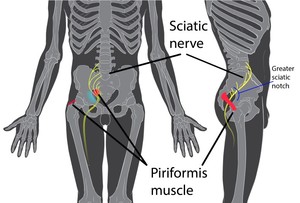
Manchmal kann Ischias zu einer seltenen Erkrankung führen, die als "Cauda-Equina-Syndrom" bekannt ist. In solchen Fällen gehören zu den Symptomen auch die Unfähigkeit, die Blase oder den Darm zu kontrollieren. [3]
Häufige Ursachen für Ischiasschmerzen
Ischias kann durch verschiedene Faktoren verursacht werden. Dazu gehören vor allem:
- Bandscheibenvorfall
- Spinale Stenose
- Spondylolisthesis
- Degenerative Bandscheibenerkrankung
- Fettleibigkeit, Unfälle und Verletzungen
- Piriformis-Syndrom
Die häufigste Ursache für Ischias ist ein Vorfall der lumbalen Bandscheiben (scheibenförmige Kassetten in der unteren Wirbelsäule). Diese Bandscheiben werden durch Stress, Trauma oder Krankheit beschädigt. 85% der Ischiasfälle sind auf Bandscheibenbeschwerden zurückzuführen. [4]
Eine Spinalkanalstenose tritt normalerweise im Nacken und im unteren Rückenbereich auf. Es handelt sich um eine Erkrankung, bei der sich der Wirbelkanal verengt. Dadurch wird Druck auf das Rückenmark und andere Nervenwurzeln ausgeübt, die von den Wirbeln ausgehen. Wenn diese Nerven zusammengedrückt und gereizt werden, führt dies zu Rückenschmerzen und Ischias. In der Regel entwickelt sich dieser Zustand im Laufe der Zeit, so dass man lange Zeit keine sichtbaren Symptome bemerkt. [5]
Spondylolisthesis ist ein Zustand, bei dem sich ein Wirbel nach vorne ausdehnt, indem er über den darunter liegenden Wirbel rutscht. Das kann die Nerven in der Wirbelsäule einklemmen und zu Ischiasschmerzen führen.
Die Bandscheiben befinden sich zwischen den Wirbeln und sorgen dafür, dass die Bewegungen der Wirbelsäule gedämpft werden. Diese Bandscheiben bestehen aus Knorpeln, die sich mit zunehmendem Alter abnutzen. Dies wird als degenerative Bandscheibenerkrankung bezeichnet, und wenn das passiert, werden die Bandscheiben anfälliger für Bandscheibenvorfälle. In bestimmten Situationen ist dies eine weitere Ursache für Ischiasbeschwerden.
Ischias kann auch durch Fettleibigkeit, Unfälle und andere Verletzungen entstehen, die den Ischiasnerv direkt betreffen.
Das Piriformis-Syndrom ist die zweithäufigste Ursache für Ischiasbeschwerden. Dabei handelt es sich um eine Verkrampfung der kleinen Muskeln unterhalb der größeren Muskeln des Gesäßes, des sogenannten Piriformis-Muskels. Krämpfe des Piriformis-Muskels können den Ischiasnerv reizen oder zusammendrücken. Und er ist oft die Ursache für schwer zu diagnostizierende Schmerzen im unteren Rücken. [6]
Wie lange dauert Ischias normalerweise an?
Glücklicherweise klingen die meisten Ischiasschmerzen innerhalb von 2 bis 12 Wochen ab, in selteneren Fällen können sie aber auch länger anhalten. Ruhe wird nur in der Anfangsphase empfohlen. Wenn die Schmerzen anhalten oder sich verschlimmern, musst du einen Arzt aufsuchen und dich behandeln lassen.
Wie man Ischiasschmerzen lindert
In den meisten Fällen reicht eine Anamnese über ausstrahlende Schmerzen aus, damit ein Arzt eine Diagnose stellen kann. Eine körperliche Untersuchung und bestimmte Maßnahmen können helfen, die Erkrankung zu bestätigen. Dennoch kann der Arzt bildgebende Untersuchungen wie Röntgen, CT oder MRT anordnen, um die Diagnose zu bestätigen und die Ursachen zu verstehen.
Glücklicherweise klingen die meisten Ischiasschmerzen innerhalb von 2 bis 12 Wochen ab, in seltenen Fällen können sie aber auch länger anhalten. Nur in der Anfangsphase wird Ruhe empfohlen. Bei den meisten Menschen umfasst die Behandlung ein Schmerzmanagement mit Hilfe von Medikamenten und Physiotherapie. In einigen wenigen Fällen mit schweren Verformungen der Wirbelsäule kann eine chirurgische Korrektur erforderlich sein.
Die Physiotherapie ist ein wesentlicher Bestandteil der Behandlung und umfasst Massage, manuelle Therapie und Bewegungstherapie. Die Physiotherapie versucht, die Ausrichtung der Wirbelsäule zu korrigieren, die lokalen Muskeln zu stärken und übermäßige Spannungen im Piriformis-Muskel zu lösen.
Ohne Bewegungstherapie können sich Ischiasbeschwerden als Probleme im unteren Rücken oder im Piriformisbereich wiederholen. Es ist wichtig, dass du dich für eine Form der Bewegung entscheidest, die deinen Körper schont, denn körperliches Training mit schnellen Bewegungen oder hoher Belastung kann mehr schaden als nutzen.
Warum Yoga bei Ischiasschmerzen
Yoga ist ideal für Menschen mit chronischen Problemen im unteren Rücken und Ischiasnervenschmerzen. Es beinhaltet keine rasanten Bewegungen, und es gibt auch keine anstrengenden Bewegungen. In erster Linie werden die Muskeln nach und nach gedehnt und gestärkt.
Bestimmte Yoga-Asanas wie Rückbeugen, Vorwärtsbeugen und sanfte Sitzhaltungen helfen, die Wirbelsäule gesund und flexibel zu halten. Yoga-Posen, die die Dehnung der Hüftbeuger, der Kniesehnen und der Gesäßmuskulatur beinhalten, sind besonders hilfreich bei Schmerzen im unteren Rücken und Ischiasbereich. In späteren Stadien, wenn die Schmerzen abgeklungen sind, ist es jedoch notwendig, auch die anderen stützenden Muskeln zu stärken. Dazu gehören die Muskeln des Beckens, des Bauches und der Rückenmuskulatur.
Bevor du Yoga gegen Ischias praktizierst, solltest du unbedingt einen Arzt konsultieren. In der akuten Phase oder bei einer schweren Hernie kann es besser sein, sich auszuruhen. Generell wird in der akuten Phase Ruhe empfohlen, da sie dazu beiträgt, die Entzündung zu verringern und weitere Schäden zu minimieren. Sobald die akute Phase vorbei ist, kann Yoga jedoch dazu beitragen, den Heilungsprozess zu beschleunigen und zukünftige Ischiasschmerzen zu verhindern. Es korrigiert die Ausrichtung der Wirbelsäule, stärkt die lokalen Muskeln und löst übermäßige Spannungen im Piriformis-Muskel.
Empfiehlt die Wissenschaft Yoga zur Linderung von Ischiasbeschwerden?
Ja, das ist richtig. Es gibt Tausende von klinischen Studien und Forschungsartikeln, die den Einsatz der Yogatherapie bei Erkrankungen des unteren Rückens unterstützen. In der modernen Medizin gelten systematische Übersichten als eine höhere Evidenzstufe zur Unterstützung einer Therapie. Bei den systematischen Übersichten handelt es sich um Studien, die die Daten aus zahlreichen Studien zusammenfassen. Anschließend wird eine statistische Analyse durchgeführt und die Wirksamkeit einer Maßnahme festgestellt.
Cramer et al. haben eine der am besten durchdachten systematischen Übersichten und Meta-Analysen über den Nutzen von Yoga bei Kreuzschmerzen durchgeführt. [7] In die Studie wurden Daten aus mehreren klinischen Studien mit insgesamt 967 Patienten mit chronischen Kreuzschmerzen einbezogen. Die Studie kam zu dem Schluss, dass es starke Belege für eine Yoga-Behandlung bei Rückenschmerzen gibt.
Die Untersuchung konzentrierte sich auf alle Ursachen von Schmerzen im unteren Rückenbereich und nicht nur auf Ischiasbeschwerden. Aber hat Yoga auch bei Patienten mit Bandscheibenvorfällen und daraus resultierenden Ischiasschmerzen geholfen? In der klinischen Zufallsstudie wurden sechzig Teilnehmer in zwei Gruppen aufgeteilt. Von ihnen hatten 62% Ischiasbeschwerden. Am Ende der Studie hatten diejenigen, die neben der konventionellen Behandlung auch Yoga gemacht hatten, deutlich bessere Werte und eine geringere Behinderung. Die Studie kam also zu dem Schluss, dass Yoga ein sicheres und wirksames Mittel ist, um Ischiasbeschwerden, die durch einen Bandscheibenvorfall verursacht werden, zu überwinden. [8]
Es gibt noch keine schlüssigen Studien, die zeigen, dass Yoga eine positive Wirkung bei Ischiasbeschwerden durch das Piriformis-Syndrom haben kann. Eine sehr gängige Behandlung in diesen Fällen sind jedoch Dehnungsübungen des Gesäßes mit Außenrotation. Diese Übungen zielen genau auf den Piriformis und die anderen seitlichen Rotationsmuskeln unterhalb der Gesäßmuskeln ab. Im Yoga gibt es eine große Auswahl an Asanas, die diese Muskeln in deinem Körper dehnen.
Wenn du Yoga gegen Ischias unterrichtest, achte darauf, dass die Schülerin oder der Schüler die akute Schmerzphase hinter sich gelassen hat. Überprüfe außerdem, ob der Arzt oder Physiotherapeut die Erlaubnis erteilt hat, Yoga zu praktizieren. Bitte die Schüler/innen außerdem darum, dich über alle Ratschläge zu informieren, die sie in Bezug auf allgemeine Bewegung und Übungen erhalten haben. Das hilft dir bei der Entscheidung, welche Haltungen und Dehnungen du machen und welche du vermeiden solltest.
9 Yogastellungen zur Linderung und Prävention von Ischiasbeschwerden
Im Folgenden findest du 9 Yogastellungen, die helfen können, Verspannungen in den Muskeln zu lösen, die Ischiasschmerzen verursachen. Diese Haltungen helfen auch dabei, die entsprechenden Muskelgruppen im Körper wieder ins Gleichgewicht zu bringen und zu stärken. Achte darauf, dass du diese Haltungen im Rahmen einer ausgewogenen Praxis anwendest. Du solltest deine Schüler/innen auch bitten, dich zu informieren, wenn sie das Gefühl haben, dass eine bestimmte Haltung oder Übung ihre Schmerzen während oder nach der Übung verstärkt. [9]
1. Drachen-Pose
Die Drachenstellung ist eine wirksame Asana bei Ischiasschmerzen. Sie wirkt tief in der Hüft- und Leistengegend und hilft dabei, die Hüftbeuger und den Quadrizeps zu dehnen und den Lendenbogen neu auszurichten.
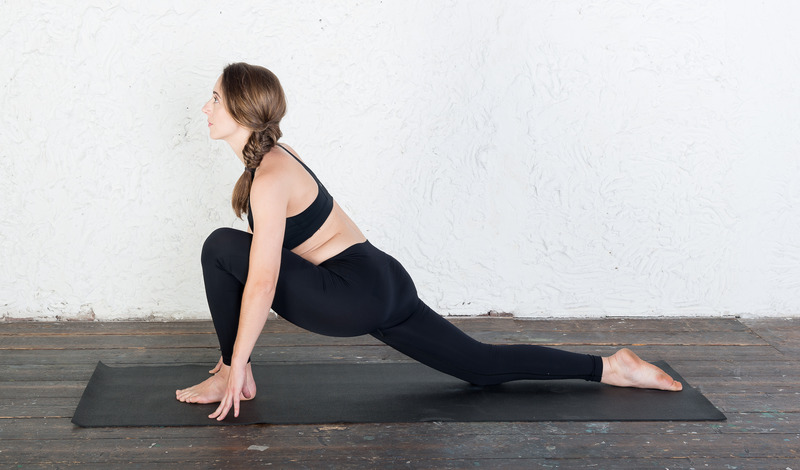
Anleitung:
- Beginne damit, dich in die Tischposition zu begeben, d.h. auf alle Viere zu gehen. Nimm dann deinen rechten Fuß zwischen deine Hände und drücke ihn sanft auf den Boden. Achte darauf, dass sich das Knie genau über der Ferse befindet und beide Hände auf beiden Seiten des rechten Fußes platziert sind.
- Als Nächstes schiebst du dein linkes Bein sanft nach hinten, so dass du eine schöne, gute Dehnung in der linken Hüfte und im linken Oberschenkel spürst. Übe keinen Druck auf das linke Knie aus, sondern hebe es nur ein wenig an. Ziehe die Zehen an und halte die Stellung 3 bis 5 Minuten lang.
- Du kannst deine Hände auf Blöcken abstützen, anstatt sie auf den Boden zu legen. Du kannst auch eine zusätzliche Decke verwenden, um dein hinteres Knie zu stützen und Unbehagen zu vermeiden.
- Um aus der Haltung herauszukommen, ziehst du dein hinteres Bein sanft nach vorne und gehst zurück in die Tischposition. Wiederhole das Gleiche mit der anderen Seite.
Gegenpose
Kindspose (Shashankasana).
Vorsichtsmaßnahmen
- Verwende Stützen, um die Knie abzufedern und den Rücken zu stützen, wenn du in diesen Bereichen Schmerzen hast oder wenn du dich zuvor verletzt hast.
- Wenn du eine der Variationen ausprobierst, sei vorsichtig, wenn du von einer Pose zur nächsten wechselst.
2. Sphinx-Pose
Diese Pose ist eine Variation der Kobra-Pose (Bhujangasana). Sie dehnt und öffnet die Schultern, den Brustkorb und die Bauchmuskeln. Sie ist auch wichtig, um das Lendengewölbe wieder aufzurichten und die Reizung des Ischiasnervs zu verringern.
Anleitung:
- Beginne damit, dich auf den Bauch zu legen und die Beine hinter dir auszustrecken. Lege deine Hände über dich und stütze deine Stirn auf die Matte.
- Als Nächstes atmest du langsam und tief ein und lässt deine Hände nach unten gleiten, bis die Ellbogen unter den Schultern liegen. Hebe dann langsam deinen Kopf, deine Brust und deinen Bauch an, indem du deine Unterarme als Stütze benutzt.
- Atme bewusst weiter und spüre den Atemrhythmus an der Vorderseite deines Beckens und im Unterleib. Du wirst auch einen leichten Druck im unteren Rückenbereich spüren.
- Zum Schluss atmest du langsam aus und bringst deinen Oberkörper, Nacken und Kopf sanft nach unten und zurück in die Ausgangsposition.
Gegenpose
Krokodil-Haltung (Makarasana)
Vorsichtsmaßnahmen
- Schwangere Frauen sollten diese Pose nach dem ersten Trimester vermeiden.
- Menschen, die vor kurzem am Bauch operiert wurden und Verletzungen im Rücken, in den Armen oder in den Schultern haben, sollten diese Haltung vermeiden. Befolge den Rat deines Arztes, wenn deine Operation oder Verletzung schon eine Weile her ist.
3. Fisch-Pose
Matsayasana oder Fisch-Pose ist eine großartige Yoga-Asana, um die Wirbelsäule auszurichten und Verspannungen in der Nackenmuskulatur, den Schultern und dem Rücken zu lösen. Sie sorgt für eine tiefe Dehnung der Hüftbeuger und der Muskeln zwischen den Rippen. Außerdem stimuliert sie die Muskeln und Organe in der Bauchregion und im Halsbereich.
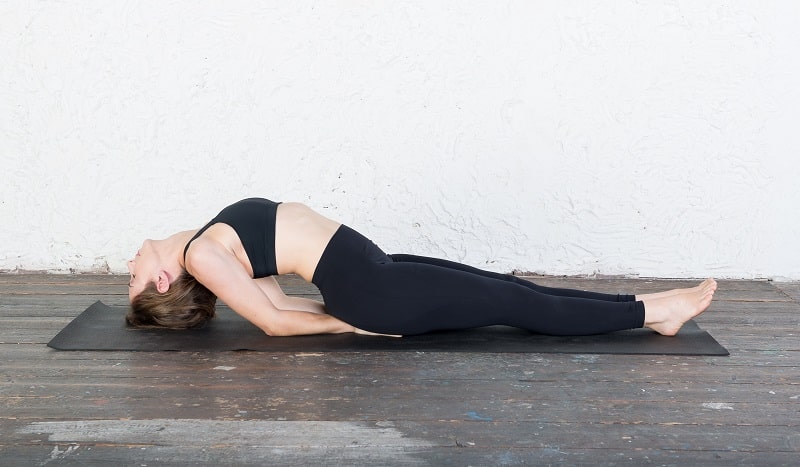
Anleitung:
- Beginne damit, dass du dich auf die Matte legst, die Hände an die Seite legst und die Beine gerade hältst.
- Als Nächstes atmest du schön tief ein, ziehst die Beine hoch, beugst die Knie und hebst langsam das Becken. Während du das Becken anhebst, schiebst du deine Hände nach unten und legst sie mit den Handflächen nach unten unter das Gesäß. Bringe deine Unterarme und deine Schultern näher an deinen Körper und lege sie in die Nähe des Rumpfes.
- Atme noch einmal ein und hebe deinen Oberkörper und Nacken langsam vom Boden weg. Dabei drückst du die Schulterblätter und deinen Kopf sanft ein wenig nach unten. Vermeide es, Druck auf den Kopf oder die Schultern auszuüben. Du wirst spüren, wie sich ein Rückwärtsgewölbe bildet, während du diese Pose machst.
- Du kannst die Knie gerade halten oder sie leicht beugen. Halte die Pose etwa 20 Sekunden lang und atme dann langsam aus und senke deinen Oberkörper und Kopf. Komme zurück in die Ausgangsposition.
Vorsichtsmaßnahmen
- Vermeide diese Pose, wenn du eine Nackenverletzung hattest.
- Menschen mit Bluthochdruck oder Herzproblemen sollten diese Pose ebenfalls vermeiden.
4. Halbe Brückenstellung
Die halbe Brückenstellung, auch Ardha Setu Bandhasana genannt, hält die Wirbelsäule geschmeidig und flexibel, was der Schlüssel zur Reduzierung und Vorbeugung von Ischiasschmerzen ist. Sie stärkt die Gesäß- und Lendenmuskeln, dehnt die Zwischenrippenmuskeln und löst Verspannungen und Schmerzen im Rückenbereich. Außerdem verjüngt sie die Beine, das Gesäß und die müde Rückenmuskulatur.
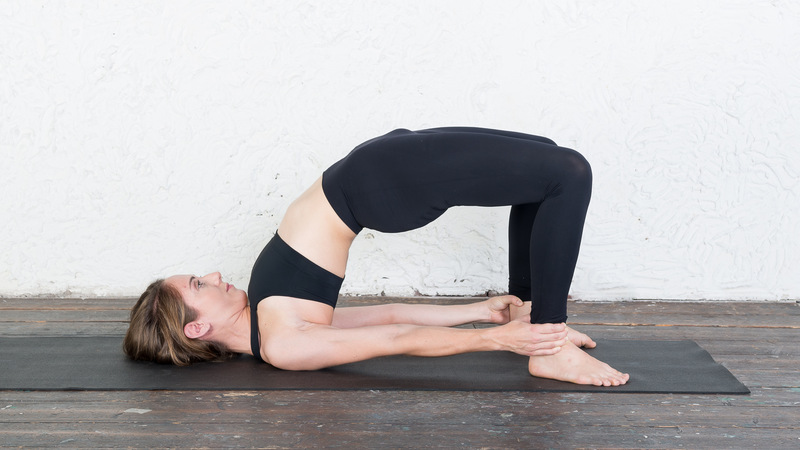
Anleitung:
- Beginne damit, dich auf den Rücken zu legen. Dann beugst du deine Knie und bringst deine Füße nahe an deine Hüften.
- Stelle die Füße hüftbreit auseinander und drücke sie fest auf den Boden. Lege deine Hände mit den Handflächen nach unten an deine Seite.
- Atme langsam ein und drücke deine Hände auf den Boden und hebe deine Hüfte sanft nach oben.
- Versuche, mit deinen Händen die Knöchel zu erreichen, während du den Brustkorb näher zum Kinn bringst. Hebe das Becken weiter nach oben und atme dabei sanft und gleichmäßig weiter.
Gegenpose
Leichenstellung (Shavasana)
5. Klassische Kobra-Pose
Die klassische Kobra-Pose oder Bhujangasana ist eine sehr empfehlenswerte Yoga-Pose bei Ischiasnervenschmerzen, da sie deinen Rücken gesund und stark hält. Sie stärkt die Rückenmuskulatur, gleicht kleine Verschiebungen der Wirbel aus und hilft dir, eine korrekte Haltung einzunehmen.

Anleitung:
- Beginne damit, dich auf den Bauch auf die Matte zu legen. Lege deine Hände auf die Seite und halte deine Beine zusammen. Drücke deine Füße, deine Oberschenkel und dein Schambein fest auf den Boden.
- Atme schön tief ein und hebe deinen Kopf, deine Brust und deinen Bauch mit den Handflächen vom Boden ab.
- Blicke diagonal nach oben, hebe deine Handflächen von der Matte und halte die Haltung für 4-5 sanfte, langsame Atemzüge.
Gegenpose
Krokodil-Haltung (Makarasana)
Vorsichtsmaßnahmen
- Vermeide diese Pose während der Schwangerschaft und wenn du eine Bauchoperation oder eine kürzliche Verletzung an Rücken, Armen und Schultern hattest.
- Wenn du eine Zerrung oder Schmerzen in deinem unteren Rücken spürst, senke dich sanft ab und gehe in die Ausgangsposition. Ruhe dich eine Weile aus und lass die Empfindungen abklingen.
6. Schulterstand
Sarvangasana bedeutet auf Sanskrit "sarva", der ganze Körper. So wirkt sich diese Haltung positiv auf die Gesamtfunktion des Körpers aus und stärkt die Tiefenmuskulatur des Rumpfes.
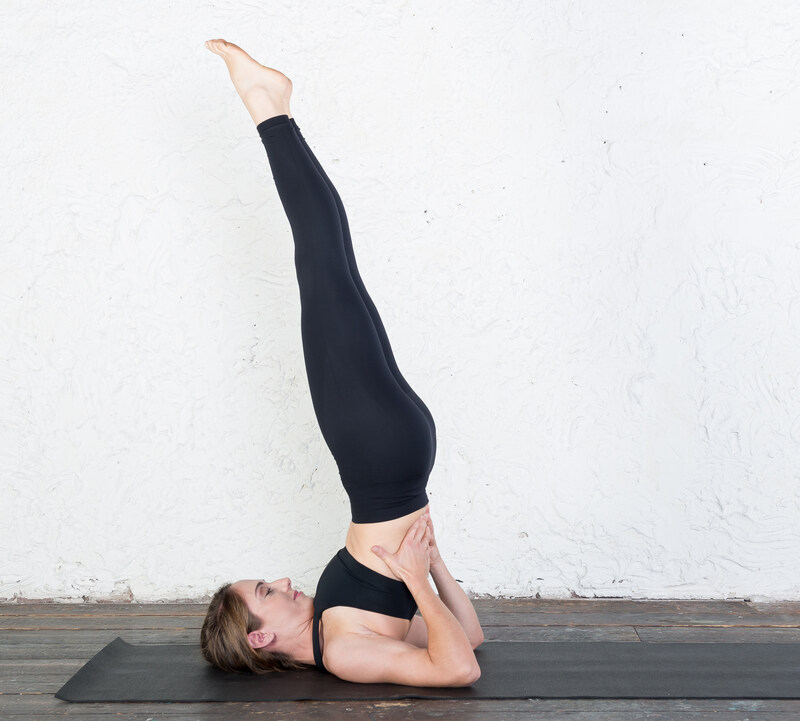
Anleitung:
- Beginne damit, dich auf den Rücken zu legen und deine Hände an der Seite zu halten. Als Nächstes beugst du langsam deine Knie und hebst deinen Körper mit einer einzigen Bewegung aus der Hüftgegend nach oben.
- Deine Beine, dein Gesäß und deine Hüften sollten sich über dem Boden befinden und das gesamte Gewicht auf deinen Schultern und Oberarmen lasten. Stütze deinen Rücken mit der Hand ab und vermeide jede Belastung für Nacken und Kopf.
- Richte deine Beine und deine Wirbelsäule auf und drücke die Ellbogen auf den Boden. Bringe die Füße über dein Gesicht. Atme tief durch und halte die Stellung mindestens 30 Sekunden lang.
- Um die Pose zu lösen, senkst du langsam deine Knie und führst sie zur Stirn. Lege deine Hände auf den Boden, die Handflächen zeigen nach unten. Bringe den Körper und die Beine langsam nach unten und halte dabei die Wirbelsäule aufrecht.
Gegenpose
Leichenstellung (Shavasana)
Vorsichtsmaßnahmen
- Menschen mit hohem Blutdruck oder mit einer vergrößerten Schilddrüse, Milz oder Leber sollten diese Haltung vermeiden.
- Wenn du eine Verletzung an Kopf, Nacken, Schultern oder Hüften hast, solltest du diese Pose vermeiden.
7. Nadelöhr-Pose
Diese Pose ist ein Hüftöffner und dehnt die Gesäßmuskeln und die tiefen Außenrotatoren gut.
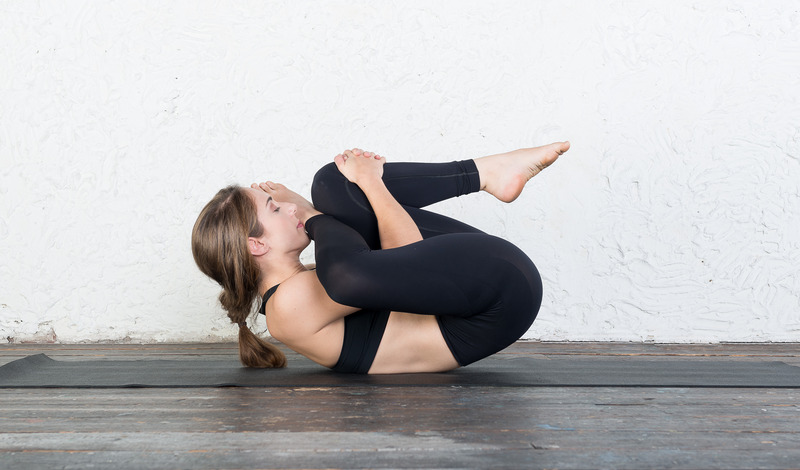
Anleitung:
- Beginne damit, dich auf den Rücken zu legen, die Knie gebeugt und die Füße fest auf den Boden gedrückt. Atme langsam ein und bringe dein linkes Knie nach oben zur Brust.
- Als Nächstes kreuzt du den linken Knöchel über den Körper und legst ihn sanft über den rechten Oberschenkel (beuge den Fuß. Halte das linke Knie von deiner Brust weg.
- Danach hebst du deinen rechten Fuß an. Während du das tust, nimmst du deine linke Hand und führst sie durch dein gebeugtes Bein (das Nadelöhr) und berührst die andere Hand. Du solltest in der Lage sein, deine beiden Hände hinter dem rechten Oberschenkel zu berühren.
- Führe deinen rechten Oberschenkel mit den Händen zur Brust. Halte die Pose 30-60 Sekunden lang.
Gegenpose
Leichenstellung (Shavasana)
Vorsichtsmaßnahmen
- Vermeide diese Pose nach deinem ersten Trimester.
- Vermeide es, wenn du Schmerzen in deinen Knien hast.
- Du kannst ein Handtuch oder einen Gurt verwenden, wenn es dir zu schwer fällt, deinen Oberschenkel zu erreichen.
8. Schnürsenkel-Haltung
Diese Pose ist ein tiefer Hüftöffner. Sie dehnt die Gesäßmuskeln und die tiefen Außenrotatoren.
Anleitung:
- Beginne damit, dich auf deine Fersen zu setzen und die Knie eng aneinander zu legen. Verlagere dein Gewicht nach rechts und setze dich auf deine rechte Hüfte.
- Als Nächstes kreuzt du dein linkes Bein über dein rechtes und legst die linke Ferse neben deine rechte Hüfte. Dein linkes Knie sollte über deinem rechten Knie liegen.
- Beuge dich sanft aus der Hüfte nach vorne. Lege deine Handflächen flach auf den Boden und halte die Stellung etwa 3 Minuten lang.
- Um aus dieser Haltung herauszukommen, drückst du dich mit den Handflächen leicht nach hinten, richtest den Rücken auf und kreuzt die Beine sanft ab. Mache eine kurze Pause und wiederhole sie dann mit dem anderen Bein.
Gegenpose
Haltung des Kindes (Shashankasana)
Vorsichtsmaßnahmen
- Vermeide diese Pose, wenn du Knieschmerzen oder eine Knieverletzung hast.
- Frauen wird empfohlen, diese Haltung ab dem zweiten Schwangerschaftsdrittel zu vermeiden.
9. Sitzende Vorwärtsbeuge
Im Sanskrit heißt die sitzende Vorwärtsbeuge Paschimottanasana und dehnt den gesamten Rückenkörper, insbesondere die Lenden- und Brustwirbelsäule, die Gesäßmuskeln und die Kniesehnen. Dadurch werden Verspannungen im unteren Rücken gelöst und Ischiasschmerzen gelindert.
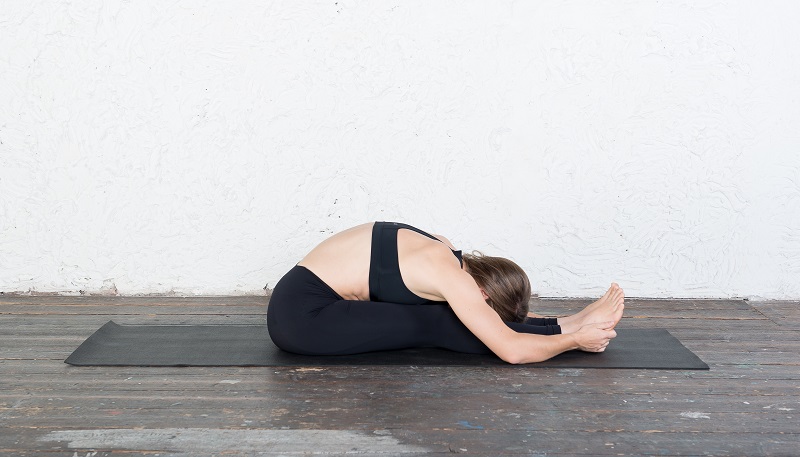
Anleitung:
- Nimm eine sitzende Position ein und stelle deine Beine gerade und hüftbreit vor dich. Drücke deine Fersen und Sitzknochen sanft auf den Boden. Atme tief ein und hebe deine Hände über dich.
- Beuge dich beim Ausatmen nach vorne und führe die Bewegung aus deinem Hüftgelenk aus. Versuche, mit deiner Hand die Zehen zu erreichen. Wenn du die Zehen nicht erreichen kannst, versuche, den Knöchel, das Schienbein oder die Knie zu berühren. Beuge dabei deine Ellbogen leicht und stütze sie sanft auf dem Boden ab.
- Um aus dieser Pose herauszukommen, atme sanft ein und rolle dich langsam auf.
Vorsichtsmaßnahmen
- Wenn du an einem Bandscheibenvorfall leidest, solltest du diese Pose vermeiden.
Fazit
Es ist wissenschaftlich erwiesen, dass Yoga Ischiasschmerzen und andere Formen von Rückenschmerzen behandeln und verhindern kann. Alle in diesem Artikel erwähnten Yogaübungen helfen dabei, die Muskeln des Körpers wieder in ein gesundes Gleichgewicht zu bringen. Daher wird empfohlen, dass Menschen mit Ischiasschmerzen neben der medizinischen Standardbehandlung auch Yoga in ihr tägliches Leben integrieren.
Statistisch gesehen ist die Wahrscheinlichkeit, dass Ischiasnervenschmerzen auftreten, sowohl bei jungen als auch bei älteren Menschen ziemlich hoch. Auch wenn wir nicht jede Ursache selbst beeinflussen können, hilft es, wenn wir einige gesunde Gewohnheiten beibehalten. Und Yoga ist eine der vorteilhaftesten Methoden, um unseren Körper auf eine sichere und schonende Weise zu pflegen.
Ressourcen
[1] https://www.ncbi.nlm.nih.gov/pmc/articles/PMC4863142/
[2] https://pubmed.ncbi.nlm.nih.gov/9820919/
[3] https://orthoinfo.aaos.org/en/diseases--conditions/lumbar-spinal-stenosis/
[4] https://www.nejm.org/doi/full/10.1056/NEJMra1410151
[5] https://orthoinfo.aaos.org/en/diseases--conditions/lumbar-spinal-stenosis/
[6] https://link.springer.com/chapter/10.1007/978-1-59745-247-2_5
[8] https://content.iospress.com/articles/journal-of-back-and-musculoskeletal-rehabilitation/bmr00531
[9] https://yoga-sci.eu/wp-content/uploads/2014/06/6-romanov-radak-e.pdf

